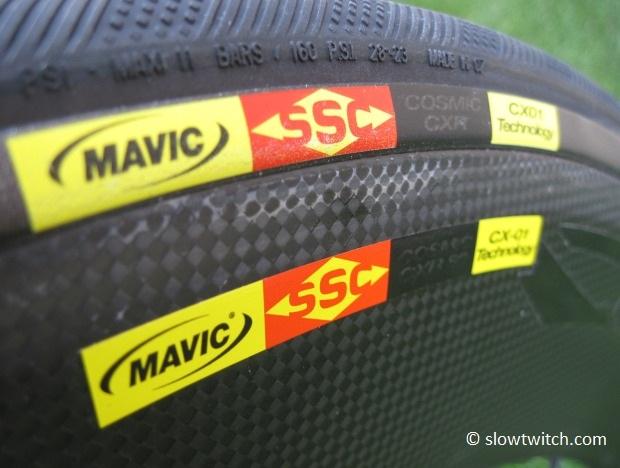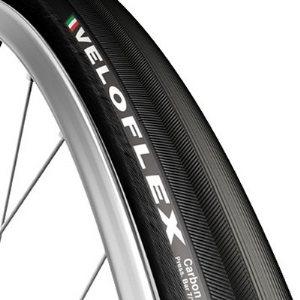This is the new Mavic Cosmic CXR80. Yes, the wheels you’ve seen under professional road racers for a some time now, in various forms. The key unique feature of these wheels is a proprietary elastic strip, which Mavic calls the “Blade”. The intention with this Blade is to perfectly blend the surfaces of the tire and rim, by filling the space in between. This has been done for years in garage-shop operations, simply by using some sort of silicone gel (which dries in to place). The Mavic system is decidedly more elegant, but we wanted to see if it actually worked… at least from a mechanical perspective, as we don’t have our own wind tunnel.
Aside from the Blade, the rest of the wheel is all-new. What’s new? They’re wide. Similar to the trend of other wheel manufacturers, these wheels are really wide. My calipers measured the middle of the braking surface at 27.2mm, and Mavic says the widest point on the rim sidewall is 28mm. This is a big departure for Mavic; their next-widest option is the Cosmic Carbone 80, at 24.8mm – and everything else in their lineup is narrow. Mavic has gotten some heat in the past for being too traditional, slow-moving, and having a blasé attitude towards aerodynamics. Well, kids – times, they are a’changing. I can tell you just by looking at these wheels that they are most certainly faster than all of the other Mavic wheels. The wind tunnel data – even if it’s from a competing wheel manufacturer – doesn’t lie. Wide rims work. I also used to work for one of these competing wheel manufacturers in my past life, so I feel comfortable making a statement such as “these look fast”. They do. If it walks like a dog and barks like a dog…

The overall width of the Mavic rim is clearly among the widest out there. Among these competitors, however, I see two camps emerging. First we have the “super blunt” shapes, which feature a very wide inner diameter of the rim (Zipp Firecrest 404 and 808, new Lightweight Fernweg, Bontrager D3 wheels). These rims tend to look very symmetrical as a system - i.e. when they have a tire mounted.
And then, we have those who seem to still have a very wide max width, not quite the super-wide rim I.D. To me, they seem a little bit more of an egg shape, at least when combined with a tire. Rims like this include the Hed Stinger and Jet, Enve Smart Systems – and now the Mavic Cosmic CXR80.

Which type is faster? I don’t know. I can tell you that both are fast. I think the real differences will come down to nuance. Perhaps one is more stable handling, but one is technically faster overall on paper.
Mavic says they optimized this rim to work best with a 23mm tire. As their data – and data from other manufacturers – tends to show, a narrower tire is always a little bit more aero. But, folks are trending away from the old 19, 20, and 21mm tires. I think it’s a good thing. Mavic’s man for all-things-PR, Zack Vestal, said that their intent was really to have the fastest “usable” wheel and tire system. That means they want low rolling resistance, good ride quality, and obviously top-notch aerodynamics.
My point here is that you should look at all wind tunnel data with a critical eye. Are the competitors testing with a 21mm tire? Or maybe a 19? What wind angle? What overall tunnel protocol? With the perfect mix of tire and wind angle, it is possible to make almost any wheel look good on paper. What we really want is a wheel that is good over a high range of wind angles and with realistic tire sizes. Time will tell if these new Mavic wheels fit the bill, but they look good on the surface.

All-new tires: Mavic Yksion CXR GripLink front and PowerLink rear. 240 grams per tire, 210 TPI casing, 23mm cross section, nylon antipuncture breaker. Zack from Mavic tells me that “The tread pattern is not an accident.”
Also interesting to note, these tires are apparently have a tubeless construction. As of now, we have very little detail about this, but intend to find out more.

Removing the rim strip is easy, but not too easy. It has an elastic strip (they yellow part) that nicely stretches and snaps in to place. I was skeptical of this initially, but after having my hands on them, it seems to work well.

Mavic says that the rim strip will lose elasticity over time if you install and remove it again and again. So, each pair of tires includes a new pair of Blades.

Now you see it...

...now you don't.

It can be hard to tell exactly what you're looking at when you see a photograph of these wheels... it all blends together (to which Mavic would respond - "EXACTLY!"). So, here is a diagram to clear things up.

As you can see, you really must use the rim strip. It would undoubtedly be a big aero penalty to ride without them.

Somewhat of a big departure for Mavic, they use a stainless steel bladed spoke (having largely been known for wide aluminum spokes). The type of spoke they chose on this wheel was clearly for aerodynamic reasons.
Of note to mechanics, however, is that there really isn't a whole lot of spoke nipple protruding from the rim. This means that you must take great care when truing the wheels, and should use a 4-sided spoke wrench.

Some very flashy carbon hubs.

We have these wheels to test long-term, and look forward to doing so.
As for the general tech and spec - Weight with tires is 2170g for the pair; 995 front and 1175 rear. Weight without tires is 1630g per pair. 725 front and 905 rear. There are 16 spokes front and 20 rear.
The rear hub comes in two flavors: SRAM/Shimano (which accommodates 9, 10, and the new 2013 Shimano 11-speed) - or Campagnolo 9/10/11-speed.
Sad to say for clincher-lovers like me, these wheels are only available in tubular. There has been no mention of a carbon clincher version in the future, but we can hope and dream.



